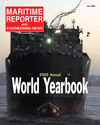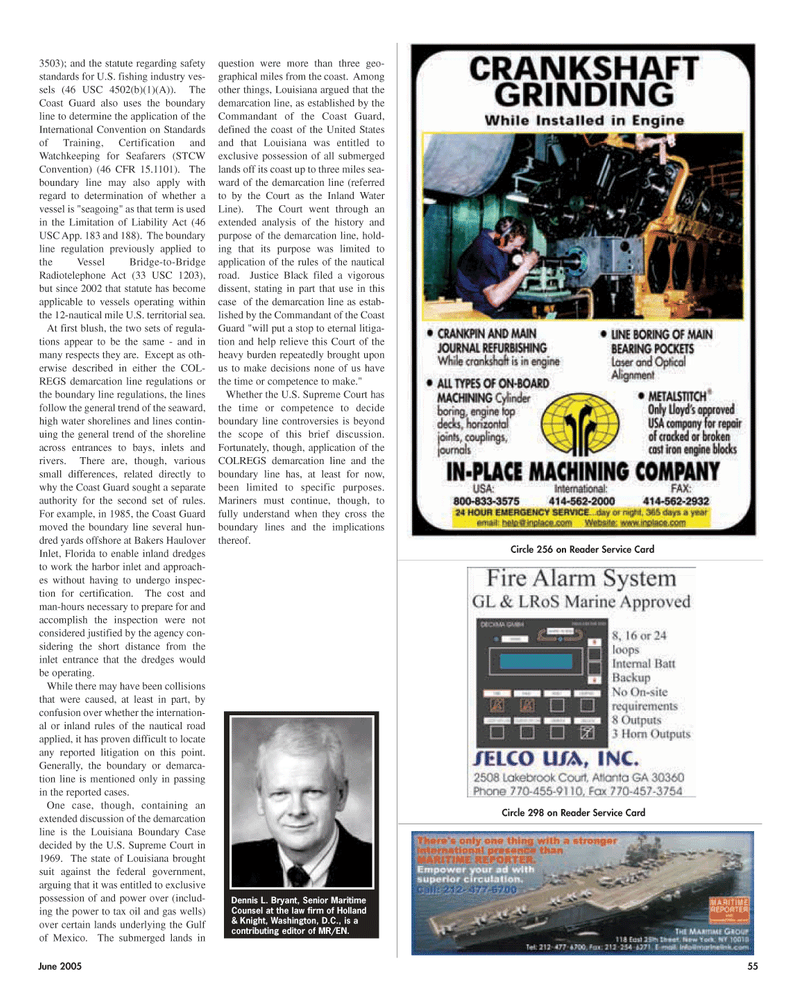
Page 55: of Maritime Reporter Magazine (June 2005)
Annual World Yearbook
Read this page in Pdf, Flash or Html5 edition of June 2005 Maritime Reporter Magazine
June 2005 55 3503); and the statute regarding safety standards for U.S. fishing industry ves- sels (46 USC 4502(b)(1)(A)). The
Coast Guard also uses the boundary line to determine the application of the
International Convention on Standards of Training, Certification and
Watchkeeping for Seafarers (STCW
Convention) (46 CFR 15.1101). The boundary line may also apply with regard to determination of whether a vessel is "seagoing" as that term is used in the Limitation of Liability Act (46
USC App. 183 and 188). The boundary line regulation previously applied to the Vessel Bridge-to-Bridge
Radiotelephone Act (33 USC 1203), but since 2002 that statute has become applicable to vessels operating within the 12-nautical mile U.S. territorial sea.
At first blush, the two sets of regula- tions appear to be the same - and in many respects they are. Except as oth- erwise described in either the COL-
REGS demarcation line regulations or the boundary line regulations, the lines follow the general trend of the seaward, high water shorelines and lines contin- uing the general trend of the shoreline across entrances to bays, inlets and rivers. There are, though, various small differences, related directly to why the Coast Guard sought a separate authority for the second set of rules.
For example, in 1985, the Coast Guard moved the boundary line several hun- dred yards offshore at Bakers Haulover
Inlet, Florida to enable inland dredges to work the harbor inlet and approach- es without having to undergo inspec- tion for certification. The cost and man-hours necessary to prepare for and accomplish the inspection were not considered justified by the agency con- sidering the short distance from the inlet entrance that the dredges would be operating.
While there may have been collisions that were caused, at least in part, by confusion over whether the internation- al or inland rules of the nautical road applied, it has proven difficult to locate any reported litigation on this point.
Generally, the boundary or demarca- tion line is mentioned only in passing in the reported cases.
One case, though, containing an extended discussion of the demarcation line is the Louisiana Boundary Case decided by the U.S. Supreme Court in 1969. The state of Louisiana brought suit against the federal government, arguing that it was entitled to exclusive possession of and power over (includ- ing the power to tax oil and gas wells) over certain lands underlying the Gulf of Mexico. The submerged lands in question were more than three geo- graphical miles from the coast. Among other things, Louisiana argued that the demarcation line, as established by the
Commandant of the Coast Guard, defined the coast of the United States and that Louisiana was entitled to exclusive possession of all submerged lands off its coast up to three miles sea- ward of the demarcation line (referred to by the Court as the Inland Water
Line). The Court went through an extended analysis of the history and purpose of the demarcation line, hold- ing that its purpose was limited to application of the rules of the nautical road. Justice Black filed a vigorous dissent, stating in part that use in this case of the demarcation line as estab- lished by the Commandant of the Coast
Guard "will put a stop to eternal litiga- tion and help relieve this Court of the heavy burden repeatedly brought upon us to make decisions none of us have the time or competence to make."
Whether the U.S. Supreme Court has the time or competence to decide boundary line controversies is beyond the scope of this brief discussion.
Fortunately, though, application of the
COLREGS demarcation line and the boundary line has, at least for now, been limited to specific purposes.
Mariners must continue, though, to fully understand when they cross the boundary lines and the implications thereof.
Circle 256 on Reader Service Card
Circle 298 on Reader Service Card
Dennis L. Bryant, Senior Maritime
Counsel at the law firm of Holland & Knight, Washington, D.C., is a contributing editor of MR/EN.
MR JUNE 2005 #7 (49-56).qxd 6/2/2005 3:09 PM Page 55

 54
54

 56
56
